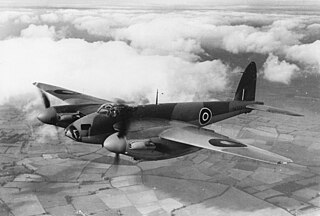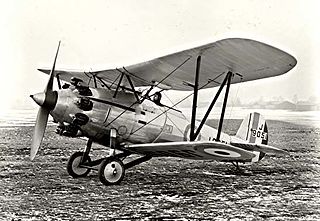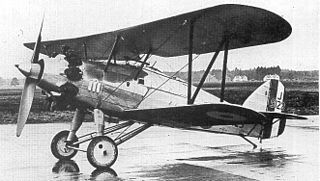
The de Havilland DH.98 Mosquito is a British twin-engined, multirole combat aircraft, introduced during the Second World War. Unusual in that its airframe was constructed mostly of wood, it was nicknamed the "Wooden Wonder", or "Mossie". Lord Beaverbrook, Minister of Aircraft Production, nicknamed it "Freeman's Folly", alluding to Air Chief Marshal Sir Wilfrid Freeman, who defended Geoffrey de Havilland and his design concept against orders to scrap the project. In 1941, it was one of the fastest operational aircraft in the world.

The de Havilland DH.103 Hornet, developed by de Havilland, was a fighter aircraft driven by two piston engines. It further exploited the wooden construction techniques that had been pioneered by the de Havilland Mosquito. Development of the Hornet had started during the Second World War as a private venture. The aircraft was to conduct long range fighter operations in the Pacific Theatre against the Empire of Japan but the war ended before the Hornet reached operational squadron status.

The de Havilland Vampire is a British jet fighter which was developed and manufactured by the de Havilland Aircraft Company. It was the second jet fighter to be operated by the RAF, after the Gloster Meteor, and the first to be powered by a single jet engine.

The de Havilland DH.110 Sea Vixen is a British twin-engine, twin boom-tailed, two-seat, carrier-based fleet air-defence fighter flown by the Royal Navy's Fleet Air Arm from the 1950s to the early 1970s. The Sea Vixen was designed by the de Havilland Aircraft Company during the late 1940s at its Hatfield aircraft factory in Hertfordshire, developed from the company's earlier first generation jet fighters. It was later called the Hawker Siddeley Sea Vixen after de Havilland was absorbed by the Hawker Siddeley Corporation in 1960.

The de Havilland DH 112 Venom is a British post-war single-engined jet aircraft developed and manufactured by the de Havilland Aircraft Company. Much of its design was derived from the de Havilland Vampire, the firm's first jet-powered combat aircraft; it was initially referred to as the Vampire FB 8 prior to the adoption of the Venom name.

The Gloster Grebe was developed by the Gloster Aircraft Company from the Gloster Grouse, and was the Royal Air Force's first post-First World War fighter aircraft, entering service in 1923.

The de Havilland DH 108 "Swallow" was a British experimental aircraft designed by John Carver Meadows Frost in October 1945. The DH 108 featured a tailless, swept wing with a single vertical stabilizer, similar to the layout of the wartime German Messerschmitt Me 163 Komet. Initially designed to evaluate swept wing handling characteristics at low and high subsonic speeds for the proposed early tailless design of the Comet airliner, three examples of the DH 108 were built to Air Ministry specifications E.18/45. With the adoption of a conventional tail for the Comet, the aircraft were used instead to investigate swept wing handling up to supersonic speeds. All three prototypes were lost in fatal crashes.

Operational Requirement F.155 was a specification issued by the British Ministry of Supply on 15 January 1955 for an interceptor aircraft to defend the United Kingdom from Soviet high-flying nuclear-armed supersonic bombers.

The Airco DH.10 Amiens was a twin-engined heavy bomber designed and produced by the British aircraft manufacturer Airco. It performed the first nighttime air mail service in the world on 14-15 May 1919.

The Armstrong Whitworth Atlas was a British single-engine biplane designed and built by Armstrong Whitworth Aircraft. It served as an army co-operation aircraft for the Royal Air Force (RAF) in the 1920s and 1930s. It was the first purpose-designed aircraft of the army co-operation type to serve with the RAF.

The Avro 604 Antelope was a British light bomber which was designed and built in the late 1920s to meet a requirement for a light bomber to equip the Royal Air Force, competing against the Hawker Hart and the Fairey Fox II. It was unsuccessful, the Hart being preferred.
The Hawker P.V.3 was a British single-engined biplane fighter prototype of the 1930s. Only a single example was built, the Gloster Gladiator being selected instead to fulfill the requirement to which it was designed.

The Bristol Bloodhound was a British two-seat reconnaissance/fighter aircraft designed and built by the Bristol Aeroplane Company as a possible replacement for the Bristol F.2 Fighter for the Royal Air Force. It was unsuccessful, only four prototypes being built.

The Vickers Vixen was a British general-purpose biplane of the 1920s. Designed and developed by Vickers in a number of variants, with 18 Vixen Mark V sold to Chile. A prototype of a version with metal wings was built as the Vickers Vivid. The Vixen also formed the basis of the closely related Venture and Valparaiso aircraft, which were also built and sold in small numbers in the 1920s

The Bristol Type 107 Bullpup was a British fighter aircraft built in the 1920s. It was not selected for squadron service and only the single prototype was built

The Westland Interceptor was a fighter developed by the British company Westland Aircraft to Air Ministry Specification F.20/27. When tested in 1929 and 1930, it showed unsatisfactory handling characteristics and was rejected by the RAF in favour of the Hawker Fury biplane fighter.
The de Havilland DH.72 was a large British three-engined biplane bomber, designed as a Vickers Virginia replacement. It did not go into production.

The Westland F.7/30 was a British fighter prototype. A single prototype was built in 1934, but the type was not put in production because its performance fell far below the RAF's requirements. The Gloster Gladiator won the F.7/30 competition.

The Hawker F.20/27 was a British fighter design built to an Air Ministry specification for an interceptor in the late 1920s. It was a single-seat biplane powered by a radial engine; the very similar but V-12-engined Hawker Fury development proved superior and only one F.20/27 was built.

The Fairey Ferret was a 1930s British general-purpose biplane designed and built by the Fairey Aviation Company. It performed well in trials but was not ordered into production.



















